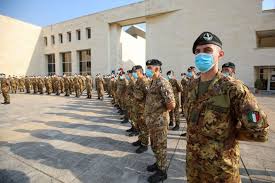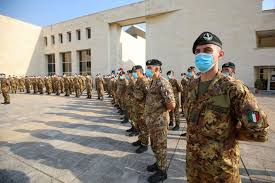Italy defense budget rebounds despite coronavirus

Rome: Italy has announced a major boost to its defense budget even as the country spends millions of euros battling the devastating effect of COVID-19 on its economy.
Overall defense ministry spending is up 9.6 percent this year to €15.3 billion (U.S. $18.1 billion), with the procurement budget emerging as the big winner as it rises by 26 percent from last year if coupled with top-up spending from the industry ministry.

“This is a very positive budget for the armed forces, especially for procurement during this challenging economic climate,” said Paolo Crippa, a defense analyst at the CESI think tank in Rome.
The figures are included in Italy’s 2020 budget, which should have been released in the spring, but was held up by the COVID-19 crisis which hit Italy hard in March and is now threatening the country again.
This year’s €15.3 billion defense ministry spending compares to just under €14 billion last year, signaling a halt in a series of year-on-year falls.
Procurement takes up €2.8 billion of the budget, up 50 percent on last year, but for a true picture of Italian procurement spending the annual top-up for domestic procurement provided by the Italian industry ministry must be added, which amounts to €2.64 billion, also up from last year.
The total to spend on procurement therefore comes to €5.45 billion, up 26 percent on last year’s €4.32 billion.
Of the other two other spending categories in the ministry budget, Maintenance and Operations rises 23 percent to €2.15 billion, while personnel spending remains stable at €10.4 billion.
“The rise in M&O spending follows claims by generals that cuts were damaging military readiness,” said Crippa.
The budget was drawn up by defense minister Lorenzo Guerini, a member of the center-left Democratic Party which governs in a coalition government with the anti-establishment Five Star party. Since first entering government in 2018, Five Star has softened its anti-military stance, which saw it initially push to scrap the F-35 program.

This year, the F-35 program receives €800 million to help conclude the purchase of the first 28 of Italy’s planned 90 aircraft buy. A further €126 million is also budgeted to get the purchase of the next 27 aircraft underway.

Other ongoing programs that get more funding in 2020 include the purchase of 650 new VTLM 2 vehicles – an upgrade of the army Lince vehicle, as well as a mid-life refurbishment for Italy’s Storm Shadow missiles and the purchase of T-345 and T-346 jet trainers.
Further programs also getting a dose of regular funding are Italy’s new, €1.17 billion LHD vessel the Trieste, a €2 billion acquisition of 150 new Centauro II wheeled tanks and a €974 million purchase of 16 new CH-47F helicopters.
Comparing the total envisaged price tag of some programs in the budget to the price listed in last year’s budget reveals costs are rising.
A plan to buy four new U-212 NFS submarines has risen from €2.35 billion to €2.68 billion this year, a hike of over €300 million.
The ongoing purchase of ten PPA naval vessels has risen over €400 million to €4.27 billion.
Some programs appear for the first time in the budget, including two new “DDX” destroyers for the Navy. No money is earmarked in 2020 but €4.5 million is due to be used for a de-risking study beginning in 2021.
A second new entry is a listing for a “multi-mission, multi-sensor” Gulfstream G-550 jet. Without stating how many aircraft Italy plans to order, the budget gives the total price tag of the program as €1.23 billion and states that funding will start in 2021.
The capabilities of the platform listed include command-and-control, “electronic superiority” and “electronic protection of forces.”
An Italian analyst who declined to be named said the program was a reprisal of a long nurtured Italian plan for a sensor platform dubbed JAMMS, which would offer signals intelligence, communications relay and radar capabilities.
The budget document states that after getting underway, the new program will take onboard future technology advancements and the benefits of “international cooperation accords.”
The analyst said, “There is a plan to buy the platform now since the Gulfstream G550 is going out of production.”
Programs on the military’s wish list which do not have any funding earmarked yet also get a mention in the budget document, starting with investment in the U.K.-led Tempest program for a future sixth-generation fighter.
But the absence of cash for the program, which the U.K. and Sweden have already invested in, risked making Italy the weakest partner in the trio, wrote Italian defense publication RID.
“In this way, there is the risk that Italy’s ability to influence the development decreases and it will be weaker when it comes to future talks on the dividing of manufacturing,” the publication stated.
The document also confirms Italy’s interest in joining the U.S. Future Vertical Lift helicopter initiative to build next generation helicopters, which is currently being pursued by the United States only.
Government officials have already mulled investing in the program using funds paid out by the EU to help the Italian economy rebound from COVID-19.
Analysts have suggested that buying into FVL may overlap with work by Italy’s Leonardo to build the AW249, a replacement for Italy’s AW129 Mangusta attack helicopter.
This year, the plan to complete a €2.7 billion purchase of 48 of the AW249 helicopters receives funding in the budget.
“There is cash for the successor to the AW129 but seeing the mention of the FVL confirms Italy is also interested in that initiative,” said Crippa.





